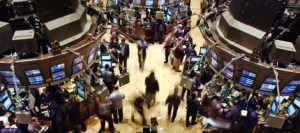
February 19, 2022 | Daily JAM, Mid Term, You Might Have Missed |
Margin debt has dropped again in January, according to FINRA (Financial Industry Regulatory Authority). The month to month drop for January is a big 8.8%. Margin debt is a useful indicator of market direction and top and bottoms. It tends to peak near a market top and signal a coming retreat in the market as lower levels of margin debt means some buyers are moving out of the market. On the other hand, corporations are buying back their own shares at a record pace.

March 5, 2021 | Daily JAM |
Maybe it was just investors and traders having second thoughts about selling stocks on a day when the economy delivered a surprisingly strong jobs report for February. After all, isn’t stronger economic growth a good thing for company revenue and earnings? Maybe it was just the normal desire not to be too long or too short going into a weekend. Maybe some of the technicians saw something that yelled “REVERSE!” If so I don’t yet see it. The NASDAQ Composite closed the day at 12920. Earlier in this drop it had sliced through the 20-day Moving average at 13609 and the 50-day a 13340 like a warm knife through butter. The 200-day moving average, the next big support isn’t until 11618. Way, way lower than where we closed today. My tentative explanation?

February 8, 2021 | Daily JAM, Mid Term, You Might Have Missed |
Stocks climbed for a sixth straight day–the longest string of gains for the Standard & Poor’s 500 since August and with the Dow Jones Industrial Average turning in its best start for a February since 1931. The S&P 500 finished the day ahead 0.34% and the Dow gained 0.76% on the session. The NASDAQ Composite was up 0.95% and the NASDAQ 100 added 0.67%. The biggest winner for the day was the small cap Russell 2000, which gained 2.53% on strength in bank stocks and hope for more growth in the general economy. Oh, and the hope for $1,400 checks to individual Americans, hundreds of billions of dollars in state and local aid and enhanced federal unemployment benefits. And continued progress on the Covid-19 vaccination program. All this means, in my opinion, that the currently stretched valuations in this stock market are likely to get even more stretched in the coming days and weeks.

October 25, 2018 | Daily JAM, Morning Briefing |
Yesterday's (Wednesday, October 24) plunge in stock prices had all the ear-marks of a margin panic, especially on the NASDAQ Composite Index. The best analysis of yesterday's margin action that I've seen comes from Don Kaufman on TheoTrade.com (You can get TheoTrade's...

November 6, 2017 | Daily JAM, Notes You Need |
In my daily trawling through the market I come upon lots of tidbits of knowledge that I think are important to investors but that don’t justify a full post. I’ve decided to start compiling these notes here each day in a kind of running mini blog that I’m calling Notes You Need. Those daily posts includes itms such as this from today: “Another chair to open up at the Federal Reserve in 2018. This time it’s at the head of the Federal Reserve Bank of New York where William Dudley will retire by mid-2018. Dudley’s term didn’t expire until 2019. The New York Fed plays a critical role in handling the Fed’s open market operations and Dudley has been one of the strongest advocates for the Fed’s policy of monetary stimulus in the years since the financial crisis. The New York Fed, rather than President Trump, will conduct the search and pick a new head to run the bank and to occupy the bank’s seat on the Fed’s governing body. I have to wonder that if, at some point, the financial markets start to worry about the huge drain in expertise at the top of the Fed with the departure of chair Janet Yellen, vice-chair Stanley Fischer, regulatory head Daniel Tarullo, and now Dudley.”







